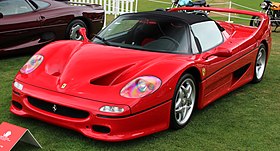
Back فيراري إف 50 Arabic Ferrari F50 BS Ferrari F50 Catalan Ferrari F50 Czech Ferrari F50 Danish Ferrari F50 German Ferrari F50 Greek Ferrari F50 Spanish فراری اف۵۰ Persian Ferrari F50 Finnish
| Ferrari F50 | |
|---|---|
 | |
| Overview | |
| Manufacturer | Ferrari S.p.A. |
| Production | 1995–1997 [1] 349 produced |
| Assembly | Maranello, Italy |
| Designer | Pietro Camardella[2] and Lorenzo Ramaciotti[3] at Pininfarina |
| Body and chassis | |
| Class | Sports car (S) |
| Body style | 2-door Targa top |
| Layout | Rear mid-engine, rear-wheel-drive |
| Related | Ferrari 333 SP Ferrari F50 GT |
| Powertrain | |
| Engine | 4.7L DOHC 65 degree Tipo F130B V12[4][5] |
| Power output | 382 kW (519 PS; 512 hp) |
| Transmission | 6-speed manual |
| Dimensions | |
| Wheelbase | 2,580 mm (101.6 in) |
| Length | 4,480 mm (176.4 in) |
| Width | 1,986 mm (78.2 in) |
| Height | 1,120 mm (44.1 in) |
| Curb weight | 1,400 kg (3,080 lb)[6] |
| Chronology | |
| Predecessor | Ferrari F40 |
| Successor | Ferrari Enzo |
The Ferrari F50 (Type F130) was a limited production mid-engine sports car manufactured by Italian automobile manufacturer Ferrari from 1995 until 1997. Introduced in 1995, the car is a two-door, two seat targa top. The F50 is powered by a 4.7 L naturally aspirated Tipo F130B 60-valve V12 engine that was developed from the 3.5 L V12 used in the 1990 Ferrari 641 Formula One car. The car's design is an evolution of the 1989 Ferrari Mythos concept car.[7]
A total of 349 cars were made, with the last car rolling off the production line in July 1997.[1] The F50's engine predated the car; it was used in the Ferrari 333 SP for the American IMSA GT Championship in 1994, allowing it to become eligible for the stock engine World Sports Car category.
- ^ a b "Ferrari F50 (1995) - Ferrari.com". Ferrari GT - en-EN.
- ^ "Rencontre avec Pietro Camardella & Gino Finizio" (in French). July 2006. Archived from the original on 26 September 2006. Retrieved 5 March 2008.
- ^ "Ferrari F50, the background". howstuffworks. Archived from the original on 14 December 2017. Retrieved 14 December 2017.
- ^ Derrick, Martin; Clay, Simon (2013). Million Dollar Classics: The World's Most Expensive Cars. Chartwell Books. ISBN 978-0-7858-3051-1.
- ^ "Ferrari F50 engine details". Ferraris-online.com. Retrieved 14 December 2017.
- ^ Cite error: The named reference
c&dwas invoked but never defined (see the help page). - ^ Jay Traugot (11 May 2013). "Ferrari F50, an evolution of the Mythos". carbuzz. Retrieved 15 December 2017.[dead link]